Do-it-yourself electric heat gun: the pros and cons of homemade + assembly instructions
The scope of thermal electric guns is quite wide. Industrial units are used to heat industrial, warehouse and even residential premises. And in small areas, you can get by with the home-made design of a heat generator, which is quite capable of heating a garage or a country house.
If you made an electric heat gun with your own hands, then it will literally cost a penny. However, in the manufacture of useful homemade work, you must follow the rules. Only in this case will the device serve no worse than the factory product.
We will tell you how to correctly make an electric gun. From the article we have proposed, you will find out what materials and components are required to assemble the unit. Our advice will help in the manufacture of efficient and economical equipment.
The content of the article:
What you need to know about the electric gun?
Unlike other types of heat guns, almost any home master familiar with the basics of electronics can make an electrical appliance.
Although the efficiency of the electric gun is much lower than diesel or gas devices, but it does not emit combustion products harmful to health and can be installed in any room - a residential building, greenhouse, utility outbuildings.
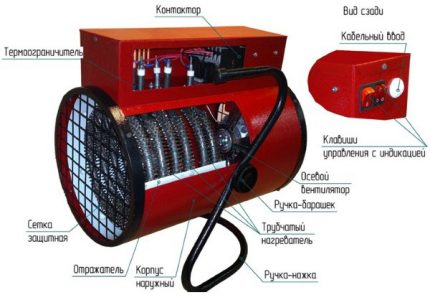
Consider how an electrical unit works.
The device and principle of operation of the heat generator
Any electric gun consists of three main components: a housing, an electric motor with a fan, and a heating element. Varieties of this type of devices are described in detail. in articlededicated to the classification and principles of action of heat guns.
In addition, the device can be equipped with any “bonuses” from the factory units - speed switch, heat regulator, room thermostat, housing heating sensor, engine protection and other elements, but they increase not only comfort and safety during operation, but also the cost of homemade work.
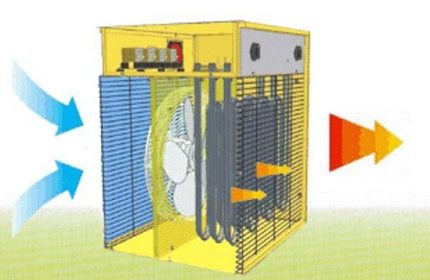
The electric gun works like this:
- when connected to the network, the heater converts the electric current into thermal energy, due to which it heats itself;
- an electric motor drives the impeller blades;
- a fan drives air from the room into the housing;
- the cold air stream contacts the surface of the heater, heats up and, forced by the fan, is removed from the "muzzle" of the gun.
If the device is equipped with a temperature control element, it will stop the heater when the programmed temperature is reached. In primitive devices, you will have to control the heating yourself.
The advantages and disadvantages of homemade guns
The main plus of the thermal electric generator is the possibility of its use in any room where there is a network of at least 220 watts.
Such devices, even in a home-made version, are mobile, weigh a little and are quite capable of warming up an area of up to 50 m2 (theoretically, it is possible and more, but it is better not to experiment with high-power devices and buy a ready-made unit, and a gun from 5 kW will already require connection to a three-phase network).
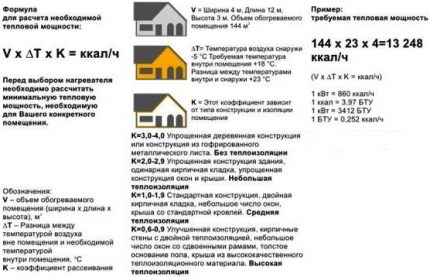
Pros of a homemade electric gun:
- Cost savings - factory units are not cheap, and you can assemble a heating device with a minimum of purchased parts or even completely from improvised means, removing the missing elements from old appliances.
- Safety - Of all the home-made heat generators, an electric appliance is the easiest to operate, since it does not require a gas connection or refueling. With proper assembly of the circuit, the risk of spontaneous combustion in such guns is minimal.
- Quick room heating - the operation of the heat gun is much more effective than other versions of home-made electric heaters, for example, fireplaces or oil radiators.
Of the minuses, a large energy consumption can be noted (the amount depends on the engine power and the heater). In addition, the fan is quite sonorous, and the larger the wingspan and rotation speed, the stronger the noise will be.
Well, any drawback of a home-made electric device is the probability of an error during assembly or connection, which can cause a circuit in the network, electric shock and spontaneous combustion of the device.
Options for manufacturing an electric gun
The most difficult step in the assembly of the device is to draw up the correct circuit diagram for connecting the device to the network. Therefore, we suggest using an already prepared example, taking it as the basis for the future heat gun. As can be seen in the diagram, the toggle switch and thermostats must be connected in series, and the circuit must be closed on the heater and the electric motor with a fan.

Consider the features of manufacturing two simple options.
Simple fan heater with ready TENOM
For the body of the future gun, you can choose a piece of metal or asbestos-cement pipe of suitable diameter. It is best to adjust the size according to the span of the “wings” of the fan, because it must overlap one of the ends of the device.
If desired, the heat generator can be made of a small metal tank, a galvanized bucket, an old pan or an exhaust gas cylinder, the main thing is that the walls of the "casing" are not thin.
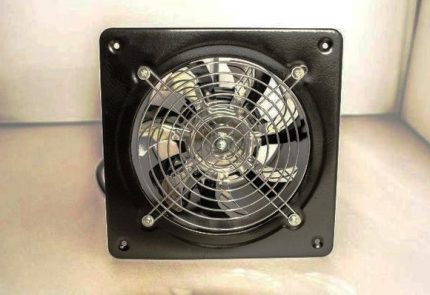
As for the heating element, you can remove this element from a used tile or boiler, or purchase it in a store - now it is not a problem to find a heater of any shape. If you buy ready-made, the fin option will be the best option, specially designed for quick heating of the moving air stream.

In addition to the three main elements (housing, engine and heater), for work you will need a three-core cable, bolts, safety machines and residual current circuit breakers (RCD), opening the network in a dangerous situation.
Phased work plan:
- Determining the required power for the future electric gun. As a starting point, you can take the common formula, according to which at 10 m2 1 kW is required (with a ceiling height of 2.5-3 m). And if the room is not insulated, is located in the basement or has a large glazing area - feel free to add another 20-30% to the received data. But if the required power exceeds 2.5-3 kW - think about whether your wiring can withstand such a load.
- Body manufacture. If it is a metal sheet - it needs to be bent and fixed in shape by welding, hoops or rivets. At a bucket, bottle or pan - saw off the bottom and lid. In a word, the frame should be a cylindrical or rectangular shape with two open holes at the ends.
- Checking the resistance of the heating element and comparing it with the calculated. If necessary, you can add another 1-2 elements by connecting them in series, or increase the power by shortening the element.
- Motor mount with fan (you can use regular fasteners). The impeller should cover the gap as tightly as possible, but rotate freely. The wires are connected to the network through a 6A fuse, equipped with a switch.
- Fixing the heating element inside the pipe (approximately in the center) using rivets or plates made of refractory materials. The distance should be far enough from the fan so as not to overheat the electric motor. The wires are led outside the case and also connected to the network, but already through a 25A fuse.
After checking the insulation of all connections, you can make a test run of the device. If everything is assembled correctly, when you plug in the plug at one end of the gun, the fan starts to rotate, and warm air comes out from the other, gradually gaining temperature.
Nichrome Heater
If your home master’s arsenal didn’t have an old household appliance, where you can remove the heater, and you don’t want to buy a finished heater for any reason, you can make it yourself from a nichrome spiral.
In addition to low cost, this element has an important advantage over factory copies - the ability to independently adjust the desired size to the housing format and increase the heating speed to a safe maximum.
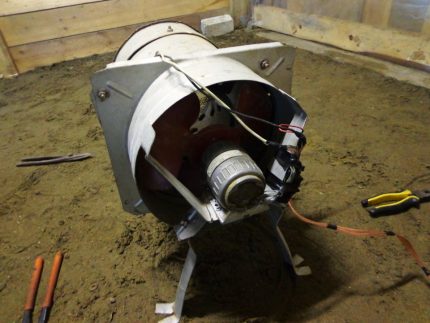
For homemade work, you will need to buy a nichrome wire with a suitable diameter and resistance parameter. And it depends on the planned power of your device (for household appliances and a 220 V network, it is advisable not to exceed 5 kW).
For example, for a gun up to 2 kW, you will need a wire with a resistance of 27-30 OM, which must be wound on a ceramic rod or other heat-resistant material (in extreme cases, you can break off a plate of refractory bricks).
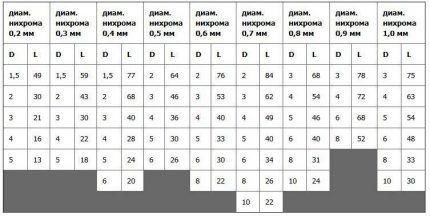
Another option is to make a home-made heater from a small segment of an asbestos-cement pipe by placing a coiled spiral from the same nichrome wire inside. You can arrange the turns horizontally and vertically to cover a large area.
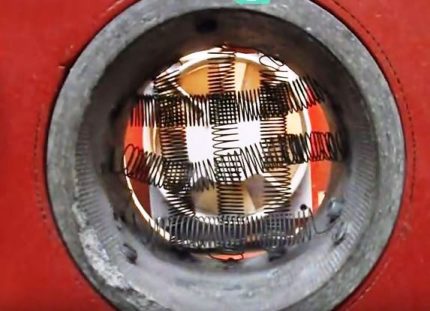
The assembly of the structure is carried out by analogy with the above instructions, so we will not repeat it at the same moments, but only consider the nuances of connecting a home-made heater:
- To keep the spiral in the correct shape, make special notches on the shaft for each coil. The wire must be wound tightly enough, but always in one layer.
- The ends of the wire must be connected to the electrical wires using bolted connections and insulated.
- The wires brought out through the holes drilled in the housing must be connected to the network through a 25A fuse.
A significant drawback of such homemade work, in addition to energy consumption and other disadvantages of electric guns, is an unpleasant burnt smell, which arises from the combustion of dust in an open spiral.
Many recommend installing a grill at the ends - such an obstacle, of course, will not cope with small debris, but it will protect against accidental contact with a heating element or a working impeller.
Some important assembly and operating tips
The rules for the safe operation of a makeshift gun practically do not differ from the operation of other electrical appliances: you must avoid tipping the device and the penetration of moisture inside it, not touching a heated case and not leaving the unit unattended.
Of the important features - before shutting down, you must first stop the operation of the heater, let the fan run idle for a few minutes, and only then pull the plug out of the mains.
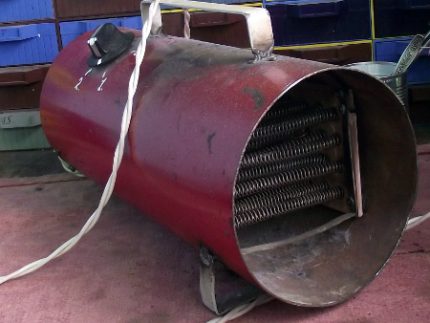
DIY assembly tips:
- The case for any type of electric gun is best made of metal with a wall thickness of at least 1 mm or asbestos cement. Although you can buy a thermoplastic container that is suitable in size, but such a “casing” can produce unpleasant odors when heated, and it will require strict control over the temperature of the spiral.
- Impeller noise from impeller operation can be reduced by using relatively quiet automotive fans for the design.
- So that the hot surface of the case does not cause a fire, it can be installed on a frame made of reinforcement, a stand made of asbestos cement, or a heat-absorbing coating can be applied.
- Power supply to the fan and the heater is always carried out separately.
- Track the insulation quality of all wires protruding beyond the gun body.
Grounding the metal housing of the device will help to avoid accidental electric shock.
And the last piece of advice is if your knowledge of electrics is at the level of an amateur novice, then before connecting a home-made device to the network, consult a master who will professionally assess the performance and safety of your creation.
With the selection criteria for a factory-made electric fan heater will introduce next article. If you doubt your own abilities or you do not have time to assemble a homemade product, read our recommended material.
Conclusions and useful video on the topic
In order to better imagine the assembly process of the entire structure, as well as possible options for the housing and heating elements, we suggest studying a selection of video materials with the finished work of home craftsmen.
Video # 1.How to make a heat generator for heating a garage from heating elements from an electric stove:
Video # 2. Electric cannon made of asbestos cement pipe and nichrome spiral:
Video # 3. 2 kW heat gun from an old fire extinguisher:
As you can see, making an electric gun with your own hands is really easy. But if you are not sure of your skills in working with the electrical part, it is better to consult an experienced electrician or buy a ready-made device.
If you have recommendations or have questions while familiarizing yourself with the material, leave posts in the box below. Please comment on the material presented by us, post a photo on the topic. Perhaps your tips will be useful to site visitors.

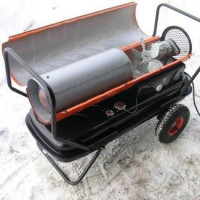 Do-it-yourself diesel heat gun: homemade manufacturing instructions
Do-it-yourself diesel heat gun: homemade manufacturing instructions 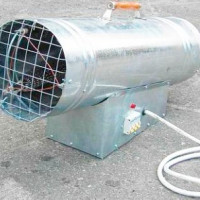 Do-it-yourself heat gas gun: step-by-step assembly instructions
Do-it-yourself heat gas gun: step-by-step assembly instructions 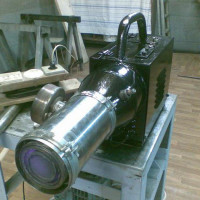 DIY heat gun: manufacturing options for different types of fuel
DIY heat gun: manufacturing options for different types of fuel 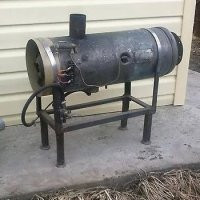 DIY heat gun for used oil: step-by-step manufacturing instructions
DIY heat gun for used oil: step-by-step manufacturing instructions 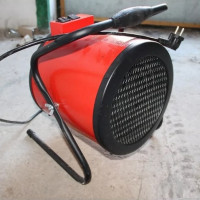 Electric heat gun: types, how to choose, an overview of the best manufacturers
Electric heat gun: types, how to choose, an overview of the best manufacturers 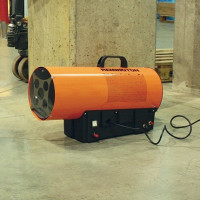 Diesel heat gun direct and indirect heating: device, principle of operation + manufacturers review
Diesel heat gun direct and indirect heating: device, principle of operation + manufacturers review  How much does it cost to connect gas to a private house: the price of organizing gas supply
How much does it cost to connect gas to a private house: the price of organizing gas supply  The best washing machines with dryer: model rating and customer tips
The best washing machines with dryer: model rating and customer tips  What is the color temperature of light and the nuances of choosing the temperature of the lamps to suit your needs
What is the color temperature of light and the nuances of choosing the temperature of the lamps to suit your needs  Replacement of a geyser in an apartment: replacement paperwork + basic norms and requirements
Replacement of a geyser in an apartment: replacement paperwork + basic norms and requirements
A useful thing, to collect it yourself is quite real. There is nothing complicated, I think, in this; the main thing is to do everything wisely and safely. The same was collected at work, since the room is large and poorly heated. All missing materials and parts are sold in stores. If you collect everything according to the rules, then it will be heated very efficiently, cheaply and cheerfully.
I assembled such a gun, approximately in the same way as described here. Already carried out internal finishing work in the fall. A thing, of course, necessary and necessary. But here is my opinion: you should not collect such things yourself, for example, I did not succeed. He warmed so that it was impossible to find in the zone of its operation. Electricity wound so that it would be better if it didn’t turn it on. To the above written comment from my own personal experience - why invent a wheel? This equipment is on sale, and, as for me, it’s better to buy it qualitatively than to assemble it yourself and suffer, and even overpay (as it was in my case).
Hello, Alexey. I partially agree with you. If you plan to constantly use a heat gun, it is better to purchase factory equipment. But many may need a heat gun for one to two times, in which case the assembly recommendations are quite relevant.
As for the excessive heat in your homemade heat gun, in this case it can be adjusted using the fan speed. There is also a more cardinal solution - replacing the spiral with another one, with a lower power indicator.
I can share my self-assembly. There is nothing complicated, I collected from improvised means without spending a dime.
I looked through many forums on this topic - the MOST important information is missing - when a spiral burns out, it breaks, and the remainder of the spiral falls on the case. ALL proposed options do NOT take this fact into account. This is a one-shot electric shock \ fire \ and so on and so on.
Dear, buy a NORMAL mass-produced device in the store!
Take care of your life and the life of others!